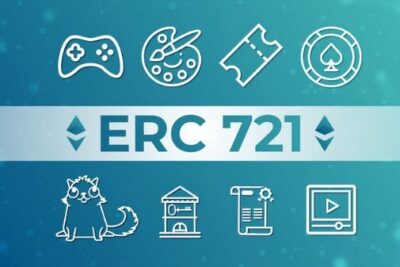

Do You Know What Is Proof Of Stake – Ultimate Information For Newbies
15 March 2022
Do you know What is proof of stake? how does proof of stake work?. Because of these advantages, most other blockchains have switched from Proof of Work to Proof of Stake.
Some users look into blockchain and proof of stake. But what is stake proof? Proof-of-stake is used in blockchains to prevent users from generating coins they don’t own. To verify transactions, a system that is independent of financial institutions is required. Proof of stake is a popular cryptographic strategy.
The original cryptocurrency, Bitcoin, uses the well-known Proof-of-Work (POW) consensus mechanism. POW miners use computer power to verify transactions and create new blocks. This led to the creation of a high-performance excavator that helps miners compete.
However, the crypto community quickly identified the POW algorithm’s flaws. This new Proof-of-Stake (POS) technique was first proposed on the Bitcointalk forum in 2011. It improves the POW algorithm.
In 2012, the first POS currency was created. That’s Peercoin. Since then, many currencies have adopted the POS algorithm.
Learn about the differences between proof of stake vs proof of work. Examine how proof of stake aims to help the bitcoin industry.
You’re gonna meet these things in this post of bePAY.
What Is Proof Of Stake And How Does It Work?
What Is Proof Of Stake?
Proof of stake protocols is a type of consensus mechanism for blockchain technology that pick validators based on the cryptocurrency holdings. This avoids the computational expense of proof-of-work approaches.
There are many ways to ensure that a distributed database is safe and secure, but one of them is a consensus mechanism. To protect the blockchain in cryptocurrency, a consensus method is used; this is known as a “blockchain consensus.”
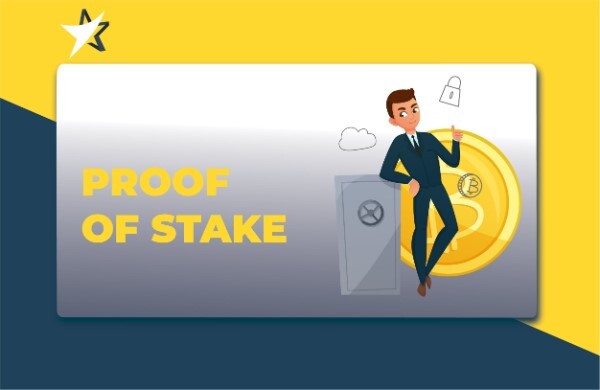
Proof of stake definition
Some key points of PoS
- Cryptocurrency owners validate block transactions using POS, which relies on the staked coins of validators to do the validate in work.
- A network assault on a POS network is considered less risky since compensation is structured in a form that allows an attack less beneficial.
- PoS uses less power than PoW.
- PoS mechanism can execute more transactions than PoW mechanism.
- PoS networks have an advantage over PoW networks in terms of scalability.
>> Read more: What is Proof of work?
How Does Proof Of Stake Work?
How Does Proof Of Stake Work? – Proof-of-stake is aimed to alleviate the scalability and ecological sustainability problems around the PoW protocol. Proof-of-work is a competitive technique for confirming transactions, which naturally motivates individuals to search for ways to gain an edge, particularly because the monetary value is involved
Using the PoS mechanism, miners are required to put up all or a part of their coins in order to confirm transactions. In general, miners who have staked more or staked for a longer period of time are given an advantage in block verification.
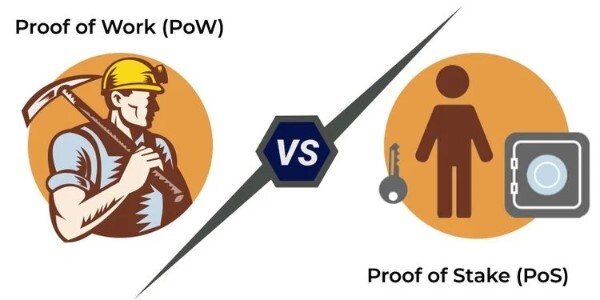
How does Proof of stake work?
In order to verify transactions, the miners must all agree on who should be chosen. Once a block has been confirmed, it is added to the chain and a reward in the form of cryptos is given to the verifier. As a result, individuals might lose all or a significant portion of their cryptocurrency investment if they do not check it correctly Since there is no motivation to cheat or steal coins, the process is more secure as a result.
The Difference Between Proof Of Stake Vs Proof Of Work
One key distinction between the two consensus systems is their use of energy. Using PoS instead of PoW reduces the amount of energy required by the network, which makes it possible to run at a much lower resource usage.
A financial penalty for network outages is imposed by both consensus procedures, which are designed to prevent malevolent actors. If a miner submits an incorrect block, they will be penalized with the computational power, energy, and time they’ve already used. Validators are financially motivated to perform in the best interest of the network under the proof of stake because of their staked crypto money. There will be a deduction from the staked money if a validator accepts a faulty block. The network determines how much a validator may be trimmed.
Another difference is Proof of stake techniques employ various ways of verifying blocks, and when Ethereum moves to PoS, it will use shards for transaction inputs. It is necessary for two-thirds of the validators to concur that a transaction is legitimate in order for the block to be closed.
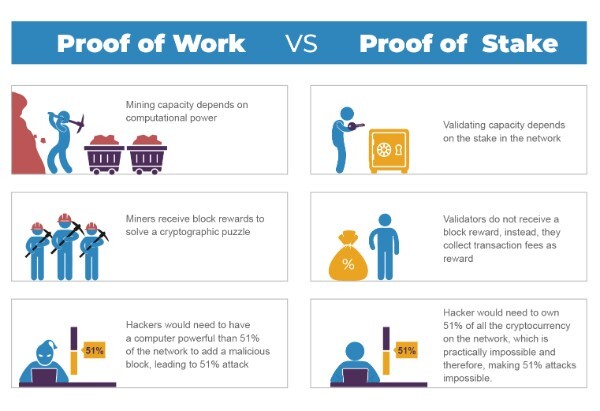
PoW vs PoS
Proof Of Stake Advantages And Disadvantages
Proof Of Stake Advantages
Below are some Proof of Stake Advantages
- Increase the number of cryptocurrencies of the possessor. So even if the bear market and the price declines, you may still benefit a little from your crypto.
- To make Proof Of Stake mining, you don’t need a powerful machine; all you need is an internet connection 24/7.
- The cost of Proof Of Stake mining is substantially less than Proof Of Work. You may sell your currency on the exchange if you no longer want to mine it.
Proof Of Stake Disadvantages
Below are some Proof of Stake Disadvantages:
- Staking is not always beneficial Holders lose if interest in their stakes is smaller than the drop in the value of their coin.
- Not all interest rate predictions come true.
- Scammer, fraud, etc. risk if you use an untrustworthy platform or a scam coin.

PoS pros and cons
>> Read more: DeFi lending and borrowing protocol – Its strengths and limitations
Some FAQs About Proof Of Stake
Why Is Proof Of Stake Safe?
The judgment to be had about whether proof-of-stake is “safe,” as the response to the question above shows. But here are some reasons. Using fewer computer resources and allowing for quicker transaction rates, proof of stake is a more efficient option. Additionally, it makes the blockchain potentially more resistant to a “51% attack.” which can solve Why is proof of stake Safe?
Is PoS Better Than PoW?
It’s not always the case. The topic Is PoS better than PoW? is still up for discussion.
Critics of proof-of-stake have been out in force. Because proof-of-stake has not yet been demonstrated to operate, Ethereum developers have been fast to trumpet its benefits. “Fundamentally difficult to create widespread consensus inside Bitcoin’s trust paradigm,” argued Blockstream Director of Research Andrew Poelstra in a mathematics article in 2015.
A greener, more efficient alternative to proof of work might emerge if proof-of-stake proves to be a successful experiment, even if it has some minor drawbacks.
What Are Validators In PoS mechanism?
A validator is like a miner in proof of work. Cryptocurrency “staker” nodes in a blockchain network commit their tokens for the benefit of the network as a whole. The number of tokens in a validator’s wallet determines whether or not they are selected to produce fresh blocks of transactions. When a validator is selected to produce a new block of transactions, other token holders who are not validators may delegate their tokens to a validator in order to get a piece of the reward.
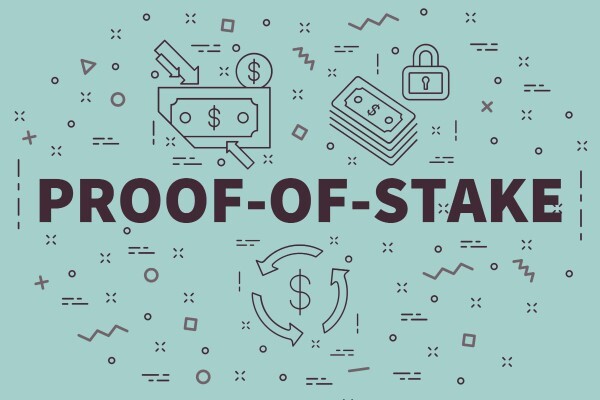
Some FAQs about PoS
When Is Ethereum Proof Of Stake Rolled Up?
And it’s still not clear when the Ethereum proof of stake roll-up will be completely operational. Proof-of-stake will be progressively deployed as part of Ethereum 2.0, a redesign of Ethereum.
What Is The Proof Of Stake Coins List?
Here is a proof of stake coins list you can take into consideration:
- Cardano (ADA)
- Polkadot (DOT)
- Solana (SOL)
- Cosmos (ATOM)
- VeChain (VET)
- Tezos (XTZ)
Closing Thoughts
Now you understand what proof of stake is and how proof of stake work. As well as the difference between PoS vs POW. It’s argued that proof of work has flaws. Some organizations have become more powerful than Bitcoin’s founder intended as bitcoin mining has become more concentrated.
For the most part, these proofs of concept phrases are used to confirm which transactions are added to the blockchain through blocks that include the most recent ones. The winner receives a prize. There are two alternative ways to choose a “winner” – the organization that will produce the next block – in proof-of-work and proof-of-stake systems.
The miners are the ones who take part in the proof-of-work system. If they have greater processing capacity, which is powered by energy, they are more likely to contribute blocks to the blockchain. With proof-of-stake, the more ether a miner has, the more blocks he or she is likely to be awarded. In other words, proof-of-stake is based on “evidence” of the amount of “stake” that users own.
Critics contend that proof-of-stake hasn’t been proved to eliminate these issues. Opponents, on the other hand, believe it is the best path ahead.













